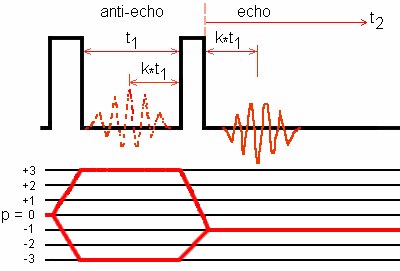Two-pulse MQ-MAS
Frydman and Harwood introduced the MQ-MAS experiment, which provides 2D high-resolution NMR spectra of quadrupole nuclei with half-integer spin in solids, by refocusing the fourth-rank elements of the second-order quadrupole interaction in spin space.
The 2D spectrum provides isotropic spectra in the F1 dimension but presents the second-order lineshapes in the F2 dimension.
The simplest MQ-MAS experiment involves two RF pulses. The first RF pulse excites all possible MQ coherences. The phase cycling allows us to select the desired MQ coherence. After an evolution period t1, the second RF pulse converts this MQ coherence into -1Q coherence.
The intensities of the ±3Q coherences generated by the first RF pulse are mainly due to the states |+3/2> and |-3/2> of the spin system before the excitation.

The echo amplitude and the antiecho amplitude have opposite signs.
| spin I | 3/2 | 5/2 | 7/2 | 9/2 |
|---|---|---|---|---|
| k | 7/9 | 19/12 | 101/45 | 91/36 |
For 3Q-MAS experiment with a spin I = 3/2,
0Q -> +3Q -> -1Q is the anti-echo pathway,
0Q -> -3Q -> -1Q is the echo pathway.
For 3Q-MAS experiment with the other half-integer spins,
0Q -> +3Q -> -1Q is the echo pathway,
0Q -> -3Q -> -1Q is the anti-echo pathway.
Since the two coherence transfer pathways are not symmetrical, amplitude-modulated experiment should not generate pure absorption 2D lineshape.
ACQUISITION: Hyper-complex or TPPI
Shearing transformation is required to obtain 2D isotropic (in F1 dimension) anisotropic (in the F2 dimension) correlation spectrum.
